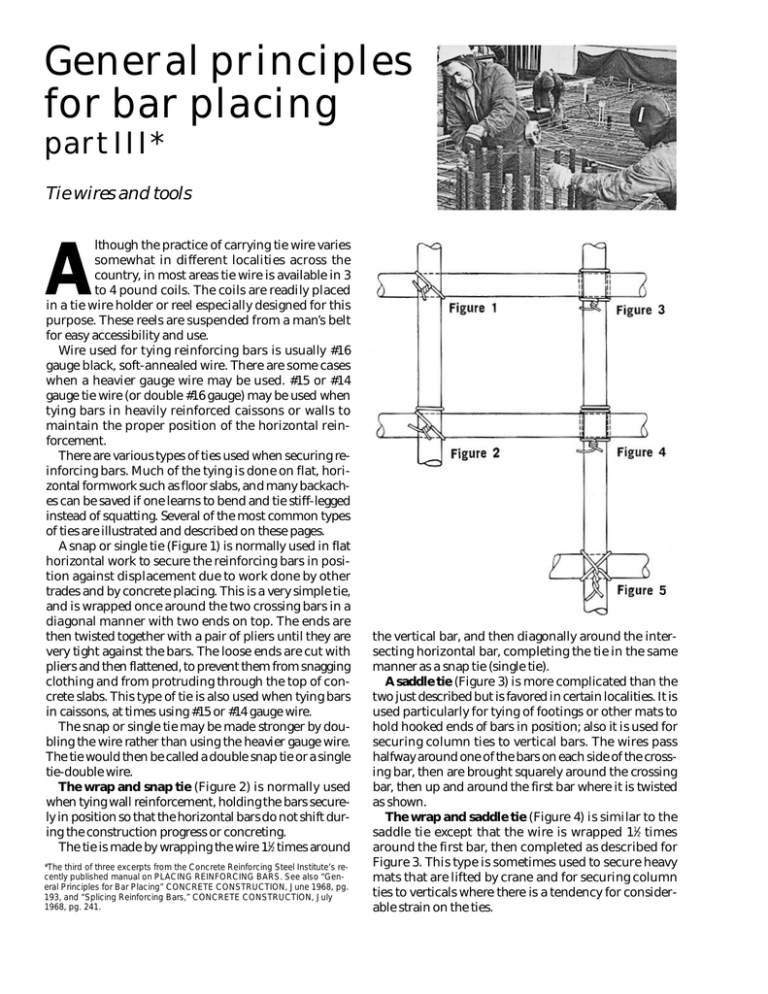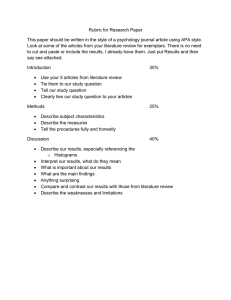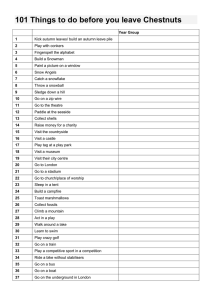
General principles
for bar placing
part III*
Tie wires and tools
lthough the practice of carrying tie wire varies
somewhat in different localities across the
country, in most areas tie wire is available in 3
to 4 pound coils. The coils are readily placed
in a tie wire holder or reel especially designed for this
purpose. These reels are suspended from a man’s belt
for easy accessibility and use.
Wire used for tying reinforcing bars is usually #16
gauge black, soft-annealed wire. There are some cases
when a heavier gauge wire may be used. #15 or #14
gauge tie wire (or double #16 gauge) may be used when
tying bars in heavily reinforced caissons or walls to
maintain the proper position of the horizontal reinforcement.
There are various types of ties used when securing reinforcing bars. Much of the tying is done on flat, horizontal formwork such as floor slabs, and many backaches can be saved if one learns to bend and tie stiff-legged
instead of squatting. Several of the most common types
of ties are illustrated and described on these pages.
A snap or single tie (Figure 1) is normally used in flat
horizontal work to secure the reinforcing bars in position against displacement due to work done by other
trades and by concrete placing. This is a very simple tie,
and is wrapped once around the two crossing bars in a
diagonal manner with two ends on top. The ends are
then twisted together with a pair of pliers until they are
very tight against the bars. The loose ends are cut with
pliers and then flattened, to prevent them from snagging
clothing and from protruding through the top of concrete slabs. This type of tie is also used when tying bars
in caissons, at times using #15 or #14 gauge wire.
The snap or single tie may be made stronger by doubling the wire rather than using the heavier gauge wire.
The tie would then be called a double snap tie or a single
tie-double wire.
The wrap and snap tie (Figure 2) is normally used
when tying wall reinforcement, holding the bars securely in position so that the horizontal bars do not shift during the construction progress or concreting.
The tie is made by wrapping the wire 11⁄2 times around
A
*The third of three excerpts from the Concrete Reinforcing Steel Institute’s recently published manual on PLACING REINFORCING BARS. See also “General Principles for Bar Placing” CONCRETE CONSTRUCTION, June 1968, pg.
193, and “Splicing Reinforcing Bars,” CONCRETE CONSTRUCTION, July
1968, pg. 241.
the vertical bar, and then diagonally around the intersecting horizontal bar, completing the tie in the same
manner as a snap tie (single tie).
A saddle tie (Figure 3) is more complicated than the
two just described but is favored in certain localities. It is
used particularly for tying of footings or other mats to
hold hooked ends of bars in position; also it is used for
securing column ties to vertical bars. The wires pass
halfway around one of the bars on each side of the crossing bar, then are brought squarely around the crossing
bar, then up and around the first bar where it is twisted
as shown.
The wrap and saddle tie (Figure 4) is similar to the
saddle tie except that the wire is wrapped 11⁄2 times
around the first bar, then completed as described for
Figure 3. This type is sometimes used to secure heavy
mats that are lifted by crane and for securing column
ties to verticals where there is a tendency for considerable strain on the ties.
Figure 6: Nailhead tie
A figure eight tie (Figure 5) is occasionally used in
walls, instead of the wall tie in Figure 2, but it is not particularly recommended because of the time required to
make the tie.
In addition, there is the nailhead tie (Figure 6) used
when nails are employed as spreaders to hold wall bars
away from the forms. The wire is wrapped once around
the nailhead, then around the outside bar of the wall
mat, drawing the bar securely against the nailhead by
twisting the ends of the wire.
The tools and equipment usually carried by the ironworker are as follows:
6-foot folding rule
Leather gloves
Colored marking crayons
Safety belt
Side-cutting pliers
50-foot steel or
Reel
cloth tape
Straight claw hammer
Hard hat
The tools and equipment furnished to the ironworker
are as follows:
Hoisting apparatus such as: small pole derrick, gin
pole, portable scaffold, towers with casters, and possibly
a cantilever cathead.
Figure 7: A tie at every fourth or fifth intersection is usually
sufficient
Bolt cutters
Hickey
Sledge hammer
Manila rope
Acetylene torch
Slings
Arc welding equipment
Chokers
Set of double or triple block falls
All of the above tools and equipment should be kept
in good working condition, clean, sharp, free-working,
well oiled, and ready for use.
GENERAL PRINCIPLES OF BAR TYING
Figure 8: Tie wall bars sufficiently to prevent shifting when
concrete is placed
The proper tying of bars is essential in order to maintain their position during work done by other tra d e s
and during concrete placing. It is not necessary to tie
bars at eve ry intersection. Tying adds nothing to the
strength of the finished structure. In most cases, a tie at
every 4th or 5th intersection is all that is necessary (Figure 7). Ends of finished ties must be kept clear of the
face of the concrete.
When tying bars in slabs that are being assembled in
place, the spacing of ties should be governed by the bar
sizes. Usually snap ties are used.
Wall bars that are assembled in place should be tied
sufficiently to prevent shifting as concrete is being placed
(Figure 8). The wall or wrap and snap tie is generally
used, but in many cases the snap tie is adequate.
For preassembled mats, a sufficient number of bar intersections should be tied to make the mats rigid enough
for handling (Figure 9). When snap ties are used, it will
make the mat more rigid if the direction of the ties is alternated.
PUBLICATION#C680291
Figure 9: Snap ties alternated for added rigidity
Copyright © 1968, The Aberdeen Group
All rights reserved





